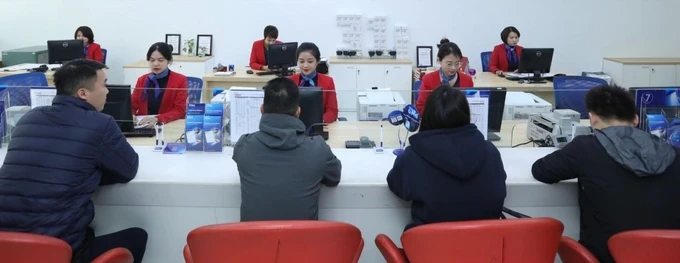
Due to a continuous drop in total demand, the Vietnam State Bank has issued a credit growth rate target of 15 percent in 2024 and assigned the credit room for each commercial bank right at the beginning of the year so that they can actively develop their own business plans. This is different from previous years, when the capital was sent in several rounds and the room could only be adjusted after bank proposals.
Receiving the credit room, all commercial banks immediately started to boost credit growth via preferential interest rate packages, loan rate reduction, and simplified loaning procedures. For instance, BVBank offers a preferential loan rate of 5 percent a year with 24-hour application review time for individuals with personal spending or house purchase/repair needs and businesses wishing to add more capital in manufacturing activities.
Similarly, Agribank has introduced a fixed interest rate of 7 percent and above per year for mid-term and long-term loans for business purposes, reduced the interest rate for real estate purposes by 0.5 percent a year. This is thanks to a double in credit room the bank receives this year, equal to VND175 trillion (US$7.1 billion).
Deputy General Director of TPBank Khuc Van Hoa shared that even though the credit room his bank receives in 2024 is the same as last year, at 16 percent, the allocation right at the beginning of the year, it is more convenient to divide the sum and set the priority fields.
The State Bank of Vietnam has set the credit growth rate target of 15 percent in 2024. This rate should be adjusted to suit the actual situation. The total outstanding credit balance of the whole economy at the end of 2023 was VND13.5 quadrillion ($550 billion). The credit amount to be released this year is estimated at VND2 quadrillion ($81.5 billion).

Standing Deputy Governor of the Vietnam State Bank Dao Minh Tu informed that the allocation of credit room at one time helps commercial banks to have a clear goal to achieve so that the economy can receive its needed capital on time. He added that if the macroeconomy is stable towards the end of this year and inflation is well under control, it is possible for the State Bank of Vietnam to deliver more credit room to commercial banks for an even higher credit growth rate.
Economic experts commented that the 15-percent credit growth rate means an abundant capital volume to be disbursed. However, whether the national economy can absorb this amount or not depends on the global economic status, which is forecast to see continuous trouble owing to the policy of anchoring a high exchange rate, leading to negative impacts on any economies depending on export activities like Vietnam.
Assoc. Prof. Dr. Dinh Trong Thinh from the Finance Academy stated that there were positive economic signs at the end of 2023. The number of newly established businesses in the fourth quarter last year enjoyed an increase of 20.2 percent compared to that time in 2022.
Orders for key export products in Vietnam such as textiles and garments, wooden furniture also witnessed a rise. The total retail sales of merchandise and consumer services in 2023 experienced a 9.6-percent growth as opposed to 2022. These are the signs that the national economy picture this year will be brighter, and thus reaching a credit growth rate of 15 percent is feasible.
Dr. Vo Tri Thanh – Head of the Institute for Brand and Competitiveness Strategy – said that whether a business can approach needed credit easily or not depends on various factors like its ability to absorb capital, the effort of commercial banks in reducing loan rates and simplifying loan procedures.
Dr. Can Van Luc – economic expert from BIDV – shared that a set target of 15-percent credit growth rate gives more space and flexibility for administration and monitoring. However, management agencies should exercise control measures over commercial banks to direct the credit flow into prioritized fields and growth driving areas. The situation of competing among banks on capital mobilization interest rates should be avoided at all costs to ensure the quality of credit and effectively control these rates in general.










)

)











